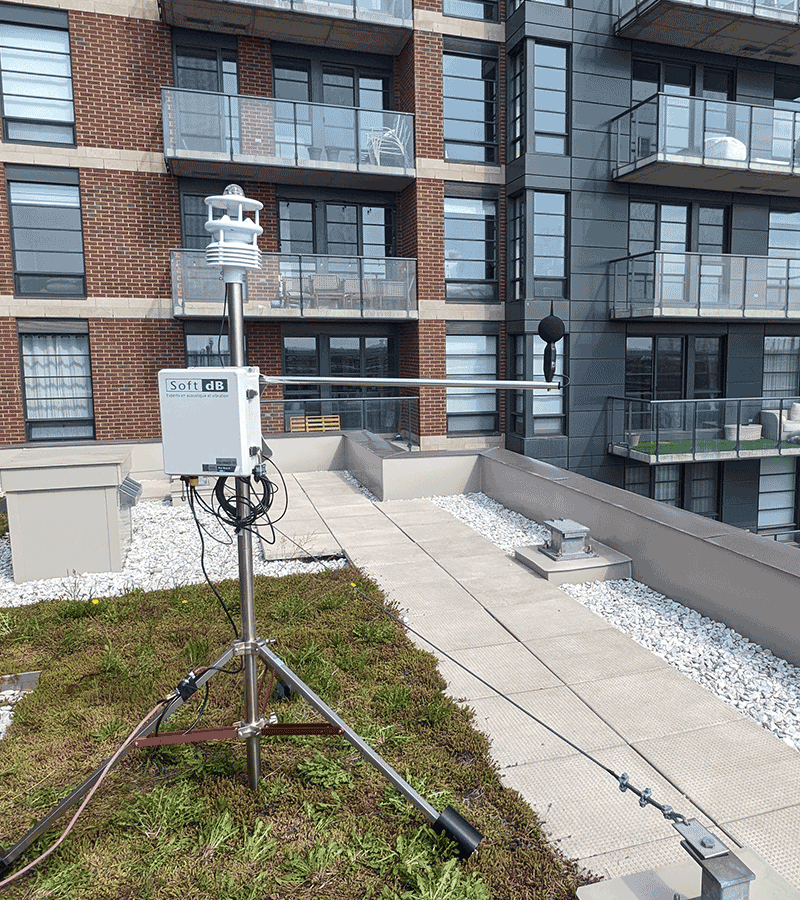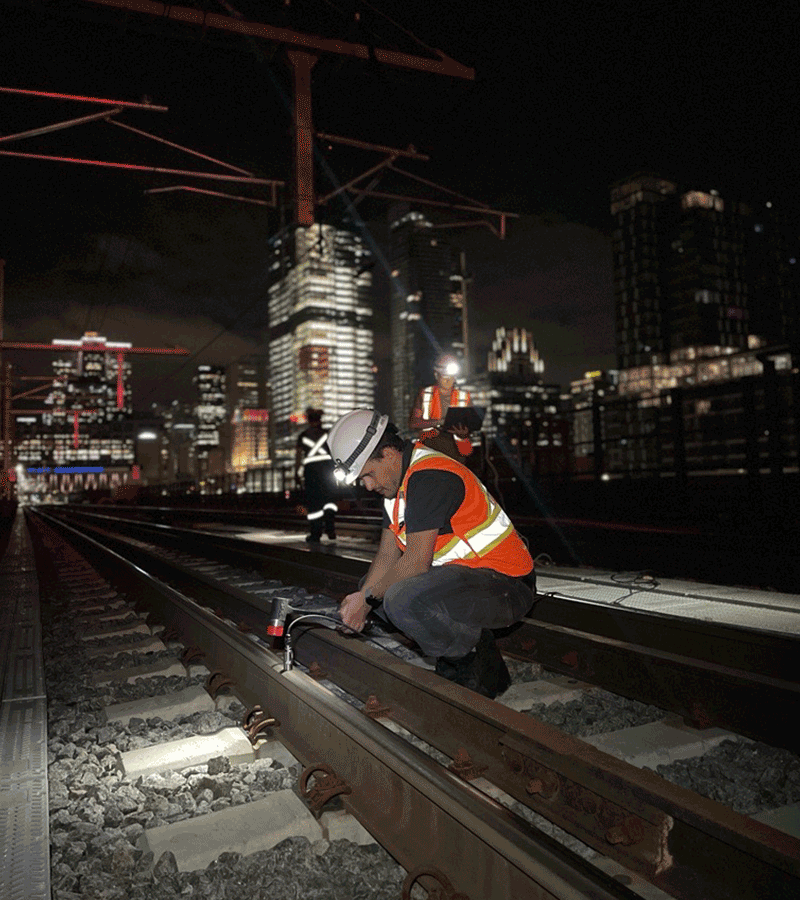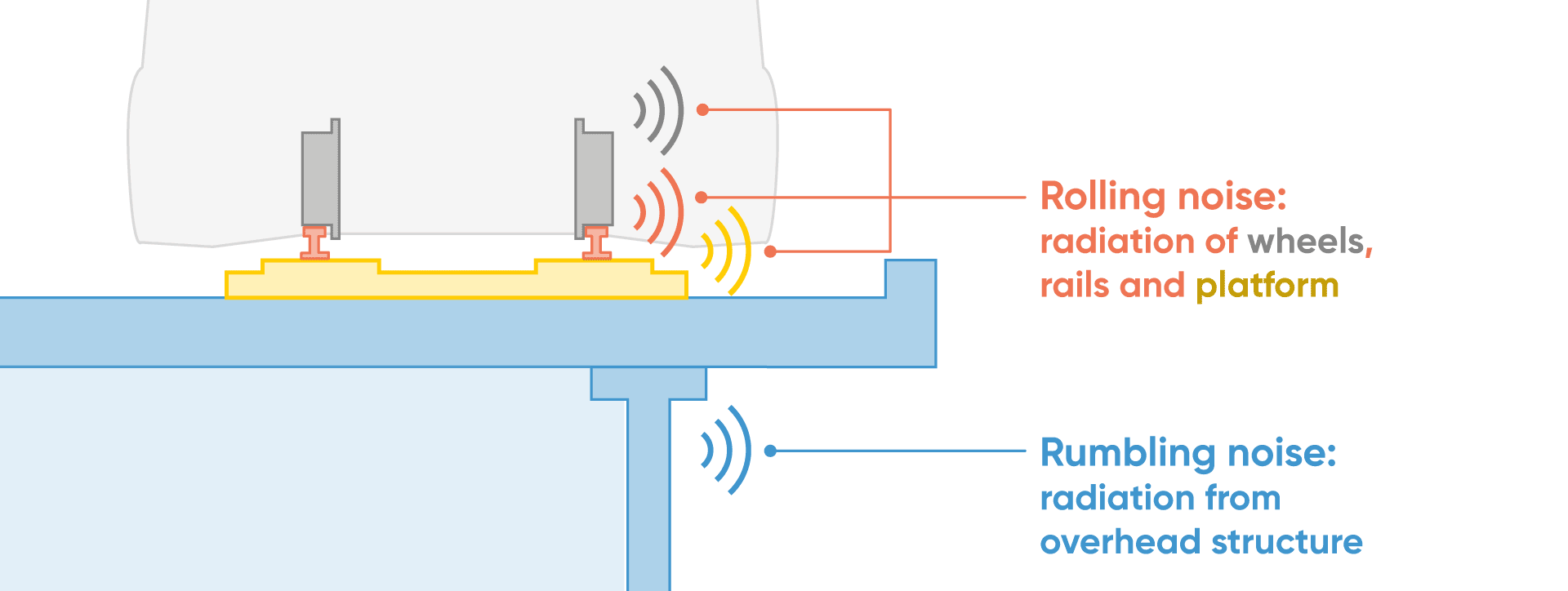
Noise from the REM in operation: Analyses and mitigation measures
When REM cars began to run more intensively in 2023, an unsatisfactory noise impact was noted in some areas on a portion of the REM’s first segment in operation.
Our team, in collaboration with international experts, set out to understand the situation and identify the right solution in the right place. Here we explain the process, the results of the analyses and the additional mitigation measures currently being deployed.
A noise measurement campaign to better understand noise sources
A noise measurement campaign was launched for spring/summer 2023 to obtain an accurate picture of the current situation and determine the measures to be taken to reduce noise.
A total of seven sound level meters were installed in residential areas in Île-des-Sœurs, Pointe-Saint-Charles and Griffintown. Griffintown and Île-des-Soeurs show higher sound levels than those indicated by initial modelling. In those areas, the differences observed can be explained in part by changes in land use, the built environment and road traffic. The noise measurements also identified emergences (or “peaks”) associated with the passage of REM cars, averaging 10 to 20 dBA, depending on the area.
Our detailed report presents the results of this noise measurement campaign by sound level meter. In addition, acoustic characterization tests were carried out on the rail and tracks to provide more detailed data on noise sources.
 Sound level meter
Sound level meter
 Acoustic characterization
Acoustic characterization
A diagnosis to understand noise sources and identify targeted measures
The REM team awarded a contract to SYSTRA, whose acoustics experts have worked on the acoustics of light rail systems around the world. The aim was to carry out an acoustic diagnosis and identify concrete mitigation measures to reduce noise for all.
From the noise measurements, SYSTRA’s experts have concluded that the main sources of noise emissions are:
- The transmission of vibrations from the track to the elevated structure, which creates a rumbling noise
- Contact between car wheels and the track, which generates a rolling noise

Following this comprehensive diagnosis, a sector-by-sector analysis was carried out to identify the right mitigation measure to deploy at the right place, based on the specific noise sources identified and the elevated structure components, which are unique to this branch.
Measurements at the source to reduce noise for all
The experts recommended two tried-and-tested noise-reduction measures that can be applied directly at source: acoustic rail grinding and the installation of dynamic absorbers on large sections of the route, as close as possible to residential areas.
Acoustic grinding, carried out using specialized equipment, reduces rail roughness. In other words, to “smooth” the track. Dynamic absorbers are used to reduce rail radiation, i.e. vibration propagation.
 Acoustic grinding | Credit : Dr. Wootae Jeong, MDPI
Acoustic grinding | Credit : Dr. Wootae Jeong, MDPI
 Dynamic absorber | Credit : Poly Corp INC
Dynamic absorber | Credit : Poly Corp INC
Following the implementation of these two measures, a reduction in total noise intensity of 5 dB to 10 dB at the source, for each passage, is anticipated. Such a reduction is equivalent to a 3- to 10-fold drop in noise levels compared to the current situation, as the noise reduction scale is calculated on an exponential, rather than linear, basis.
L’installation de murs antibruit a aussi été étudiée. D’un point de vue ingénierie, la structure du REM peut accueillir des murs d’environ 2 mètres de hauteur. Cependant, compte tenu de la configuration et de la hauteur des résidences par rapport à la structure du REM dans plusieurs secteurs d’où émanent les plaintes, l’installation de murs antibruit ne générerait aucun gain acoustique significatif. De plus, cette mesure ne diminuerait pas le bruit pour tous, comme elle ne toucherait pas le bruit de grondement, une de sources de bruit identifiées, et aurait un impact limité, soit seulement sur les premiers étages des habitations.

Rapid rollout of identified measures
The installation of absorbers began in mid-October and will continue until early December. At the same time, acoustic rail grinding will be carried out in early November on the entire segment between Île-des-Sœurs and Central Station, continuing as far as Brossard station.
Noise monitoring at the source will be carried out to verify if noise reduction targets have been met. The results of this monitoring will be shared publicly.
This work will have to be carried out at night, as it is incompatible with network operations. To limit the impact, the network has been closing earlier, at 10 p.m. from Sunday to Thursday evenings, since mid-October, between Panama station and Central Station. A shuttle bus system is in place. Full details here.

Meetings with citizens
Meetings were held at the end of September 2023 in the relevant neighbourhoods, namely Pointe-Saint-Charles, Griffintown and Île-des-Sœurs. Our team presented the analyses performed and the planned mitigation measures and answered questions. Nearly 600 people attended in person or online. Recordings of the meetings and associated documentation are available here.
Following these meetings, and in response to requests from citizens, data on the passage have been added to our full report.
In anticipation mode for the rest of the network
The structure type is different for the rest of the network, with tracks mostly on crushed stone (ballast) and an elevated structure with concrete segments, which is different from the elevated structure on the South Shore branch.
We have confirmed that acoustic grinding will be carried out all along the route, including the portion not yet in service. Analyses are also underway to validate the modelling, confirm whether the planned measures are sufficient, and enable adjustments to be made if necessary. Monitoring will also be carried out during the test period.
Reminder: The regulatory framework for noise during operation
The REM project is governed by a regulatory framework established by the Québec government. This framework provides for sound modelling of the REM in operation, in accordance with the Politique sur le bruit routier [policy on road noise] of the Ministère des Transports et de la Mobilité durable, the implementation of mitigation measures in the event of significant impacts, and a sound climate monitoring program.